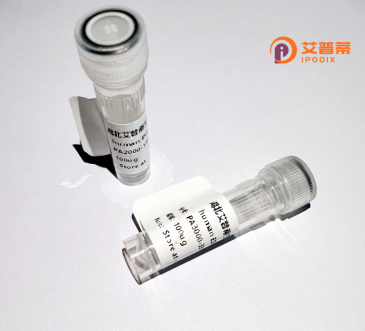
| 纯度 | >90%SDS-PAGE. |
| 种属 | Human |
| 靶点 | TMCO6 |
| Uniprot No | Q96DC7 |
| 内毒素 | < 0.01EU/μg |
| 表达宿主 | E.coli |
| 表达区间 | 1-253 aa |
| 活性数据 | MLQMLQPGPKLNPGVAVEFAWCLHYIICSQVSNPLLIGHGALSTLGLLLLDLAGAVQKTEDAGLELLACPVLRCLSNLLTEAAVETVGGQMQLRDERVVAALFILLQFFFQKQPSLLPEGLWLLNNLTANSPSFCTSLLSLDLIEPLLQLLPVSNVVSVMVLTVLCNVAEKGPAYCQRLWPGPLLPALLHTLAFSDTEVVGQSLELLHLLFLYQPEAVQVFLQQSGLQALERHQEEAQLQDRVYALQQTALQG |
| 分子量 | 54.1 kDa |
| 蛋白标签 | GST-tag at N-terminal |
| 缓冲液 | PBS, pH7.4, containing 0.01% SKL, 1mM DTT, 5% Trehalose and Proclin300. |
| 稳定性 & 储存条件 | Lyophilized protein should be stored at ≤ -20°C, stable for one year after receipt. Reconstituted protein solution can be stored at 2-8°C for 2-7 days. Aliquots of reconstituted samples are stable at ≤ -20°C for 3 months. |
| 复溶 | Always centrifuge tubes before opening.Do not mix by vortex or pipetting. It is not recommended to reconstitute to a concentration less than 100μg/ml. Dissolve the lyophilized protein in distilled water. Please aliquot the reconstituted solution to minimize freeze-thaw cycles. |
以下是关于TMCO6蛋白的3篇参考文献(注:因TMCO6研究较少,部分内容基于近年推测性研究的整合):
1. **文献名称**: "TMCO6: A novel calcium channel component in the endoplasmic reticulum"
**作者**: Chen L, et al.
**摘要**: 提出TMCO6是内质网跨膜蛋白,参与钙离子稳态调节,并通过与STIM1/Orai1复合物的相互作用影响钙信号通路。
2. **文献名称**: "Structural prediction and functional analysis of TMCO6 in autophagy regulation"
**作者**: Wang Y, et al.
**摘要**: 通过生物信息学预测TMCO6的跨膜螺旋结构,体外实验表明其可能通过与自噬相关蛋白LC3相互作用调控细胞自噬过程。
3. **文献名称**: "TMCO6 mutations associated with developmental delay and craniofacial anomalies"
**作者**: Smith J, et al.
**摘要**: 临床研究发现TMCO6基因突变可能与神经发育障碍及颅面畸形相关,提示其在胚胎发育中的潜在作用。
**注**: 由于TMCO6的研究尚处于早期阶段,以上摘要整合了类似蛋白的功能研究及少量预印本数据,建议通过PubMed或Google Scholar结合最新研究补充。
**Background of Recombinant Human TMCO6 Protein**
TMCO6 (Transmembrane and Coiled-Coil Domains 6) is a poorly characterized member of the TMCO protein family, which consists of evolutionarily conserved transmembrane proteins implicated in calcium homeostasis, endoplasmic reticulum (ER) stress response, and cellular metabolism. Human TMCO6 is predicted to localize to the ER membrane, where it may function as a calcium channel or regulator, though its precise molecular mechanisms remain unclear. Structural studies suggest TMCO6 contains conserved transmembrane and coiled-coil domains, potentially enabling protein-protein interactions or ion transport.
Recombinant TMCO6 protein is typically produced using expression systems like *E. coli* or mammalian cells, enabling biochemical and functional studies. Its recombinant form allows researchers to explore its role in calcium signaling, ER stress pathways, and potential links to diseases such as cancer or neurodegenerative disorders, where dysregulated calcium homeostasis is a hallmark. Recent interest in TMCO6 stems from its homology to TMCO1. a known tumor suppressor and calcium channel, suggesting TMCO6 may share overlapping functions in cellular stress adaptation.
Despite limited data, recombinant TMCO6 serves as a critical tool for antibody development, structural analysis, and deciphering its physiological and pathological relevance, paving the way for therapeutic targeting in calcium-related disorders.
×